Mitigating the Impacts of COVID-19 in a Fragile State: Key Findings from the RECOVR Sierra Leone Survey
By John Branch, Shahana Hirji, Andreas Holzinger, Amara Kallon, and Shana Warren
COVID-19’s impacts are global, but they are also filtered through unique local and national contexts. As one of the poorest countries in the world, Sierra Leone is a setting that is particularly vulnerable to public health crises, and one that unfortunately has had recent experiences with them: the Ebola outbreak in 2014 led to a collapse of the health system, with 7 percent of the country’s health workforce dying and the economy sliding into a prolonged recession.
Like most countries, Sierra Leone has made drastic changes to everyday life to mitigate the spread of COVID-19. Schools closed on March 31, and the country instituted a pair of national lockdowns from April 5-7 and May 3-5. Land borders were entirely closed from late March to June, and a national mask mandate began on June 1.
Amid these policy efforts, IPA ran the first round of our RECOVR survey in Sierra Leone from May 27 to June 19. Conducted to inform the policy efforts of the Ministry of Health and the Bank of Sierra Leone, we surveyed 1,304 respondents about a range of health, economic, and education outcomes using random digit dialing, making them statistically representative of the set of active mobile phone numbers held by adults in Sierra Leone. A large percentage of these respondents are urban residents of the capital district. This blog post summarizes the key findings and their policy implications. (More information about the RECOVR survey, a cross-country panel survey that is tracking the socioeconomic impacts of COVID-19 over time in nine countries, is available here).
A majority of respondents report that they are still accessing healthcare services, but mental health is a concern.
A key policy question for Sierra Leone’s Ministry of Health has been whether patients are still able and choosing to access needed healthcare services and whether respondents with small children are visiting community health centers for vaccinations and antenatal care. So far, the answer is largely yes: only six percent of survey respondents reported that they had skipped a needed visit (with about half of that six percent citing concerns due to COVID-19 as the reason) and seven percent said they were unable to obtain prescription medication. Most respondents (over 80 percent) felt confident that they could seek medical assistance from a community health clinic.
About one in ten respondents reported that someone in their household had developed a mental health symptom like anxiety, sadness, or difficulty sleeping since schools closed on March 31. Poorer households were slightly more likely to report this than wealthier ones. Further research could answer questions on the age range in which mental health concerns are most prevalent, and on how COVID-19 may intersect with other crises and difficult situations to exacerbate mental health conditions.
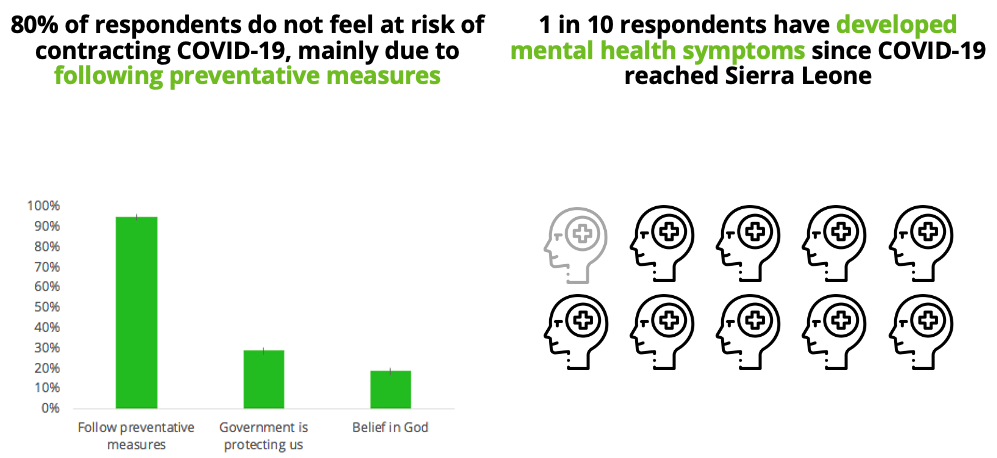
Economic activity and employment have been heavily affected.
Almost 70 percent of respondents reported that they were working fewer hours than they did in a typical week before the pandemic. Nineteen percent of workplaces are currently open with no disruptions, 28 percent are completely closed, and almost 40 percent are open with reduced operations. Of respondents who were employed before the pandemic, 36 percent report earning less in a typical week.
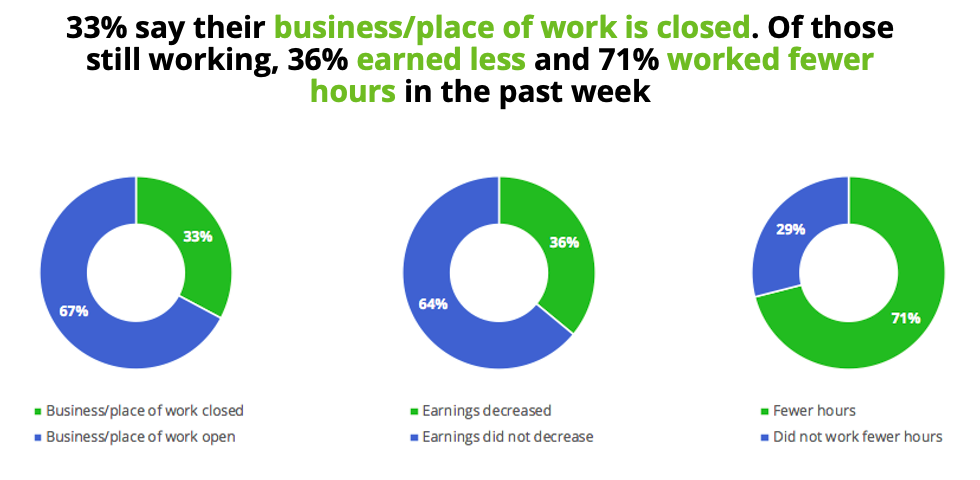
Respondents’ economic well-being has fallen quickly and sharply.
A majority of respondents (about 60 percent) report that they have had to deplete savings in order to afford food, healthcare, or other expenses since February 2020. Large minorities have also taken other steps, such as buying fewer economic inputs than planned (over 30 percent), selling off assets such as livestock (over 20 percent), or skipping a required loan payment (over 20 percent). Not surprisingly, poorer respondents are more likely to report all of these mitigation strategies than richer ones.
The vast majority of respondents, about 90 percent, said they had not received economic assistance from the government since the pandemic began. On June 6—near the tail end of this survey round—the government’s National Commission for Social Action (NaCSA) began providing one-off transfers (of cash, social services, or protective equipment) to vulnerable residents—mostly those working in the informal sector or for small firms in urban areas.
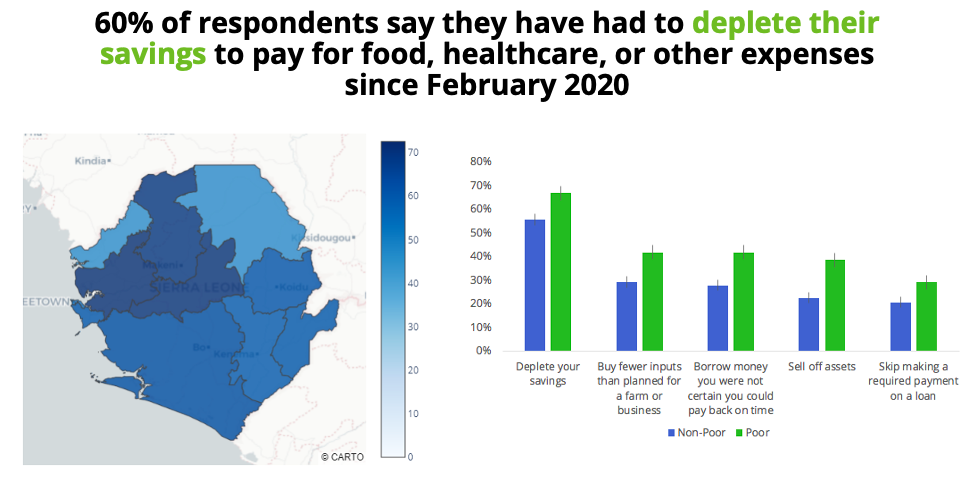
Food security has taken a big hit.
Several measures suggest that the economic impact of the pandemic has had consequences on households’ ability to eat enough food. Over 40 percent of respondents reported both limiting portion sizes at meals and reducing the number of meals they eat per day; nearly 80 percent say that they have had difficulty buying food at markets because prices are too high, with 70 percent reporting that dropping household income has caused difficulty at food markets too. Across all of these measures, poorer households have been hit harder than wealthier ones. Impacts on food security notably differ by region.
One reason for the high prevalence of food insecurity in this survey may be that a majority of respondents live in urban areas: most urban Sierra Leoneans rely on cash income for food, while rural residents are more likely to be smallholder farmers who grow their own. A survey of smallholder farmers in neighboring Liberia by Jonathan Robinson et al. found that, while rural markets were disrupted by the pandemic, food security was largely unaffected.
A topic of particular importance, given the long-term implications of food insecurity for child development, is how the food security of households with children fares compared to those without. Households with school-aged children report more difficulty buying food at markets than those without; however, so far, they have not reported skipping meals or reducing portion sizes at higher rates than other households.
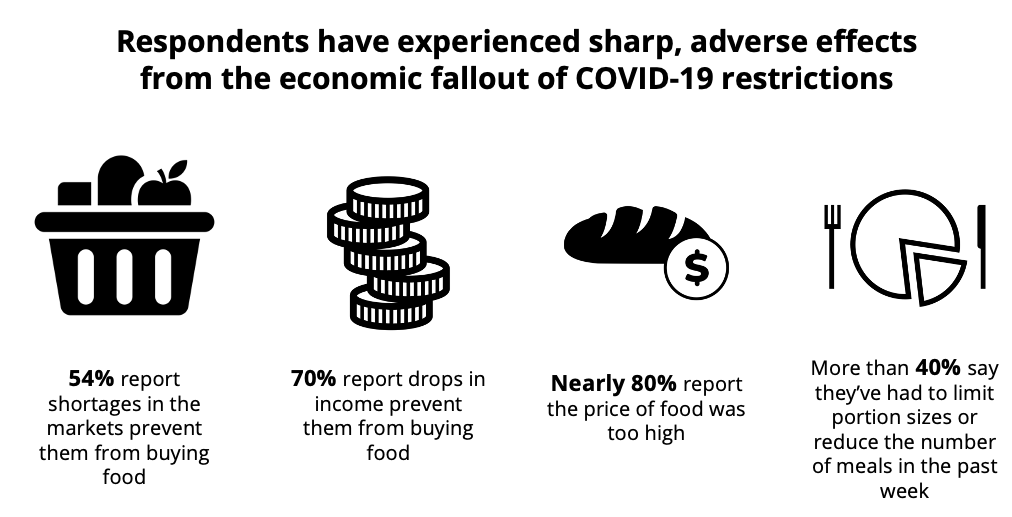
A majority of children are spending more than two hours per day on education at home.
Nearly 80 percent of respondents reported that all children in the household enrolled in primary and secondary school were spending time on education, and almost 60 percent were spending an average of over two hours per day. The proportion of children still spending time on education was similar across economic lines, though children from wealthier households were slightly more likely to devote over two hours per day.
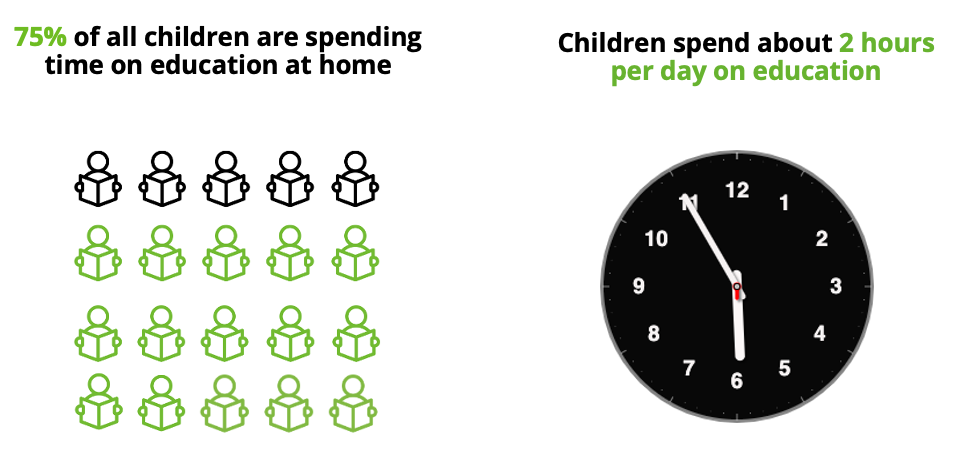
Similar to the survey’s findings in Ghana, children in Sierra Leone are mostly using their own school books to continue learning from home, rather than radio broadcasts, the internet, or other alternative forms of education.
A majority of children are spending more than two hours per day on education, which is far less than a child would receive in a typical school day. Most parents (63 percent) reported that their main concern about their children’s education was falling behind in school. This is a striking insight, given that other options respondents could have chosen as a main concern included the safety or health of their children.
Looking Forward
Future rounds of the RECOVR survey in Sierra Leone will measure how the outcomes discussed above are changing over time. In the coming weeks, we will discuss these findings and their policy implications with government partners. Priority policy questions include:
- How can we make sure respondents have access to and are aware of mental health services? As we mentioned in last week’s results webinar, mental health is an important issue in diverse realms of public policy. People in Sierra Leone have often experienced a range of traumas, and few mental health resources are currently available. Targeting efforts to improve access to those who need it the most is a primordial consideration.
Is the government adequately providing economic support to those who need it most? The economic impacts of the COVID-19 crisis differ across many domains—such as urban vs. rural residents, occupation, and household size. Economic support should be targeted to those with the most acute need. As noted above, government transfers via NaCSA began at the end of this survey round, and we expect the next survey round to illuminate how broad this program’s reach among vulnerable populations has been.
How can we support the food security of children? At the beginning of June (and the tail end of our survey), the FAO, in partnership with the Ministry of Agriculture, started the Special Fund for Emergency and Rehabilitation Activities, which is aiming to support vulnerable and food-insecure households. Food ration programs targeted at households with children and reinstating school meal programs before in-person education returns may be an additional way to support vulnerable children.
How can we ensure that students don’t fall behind when school resumes? Sierra Leone’s education system is focused on radio broadcasts to provide distance learning—how can access to radio distance learning be expanded so that fewer students are limited to studying with solely their own school books, and how can it be targeted to ensure that students are getting instruction at the right level?
As Sierra Leone’s policy response to COVID-19 continues to take shape, we are excited to continue to support our government and development partners to use this data for evidence-based decision-making, and in the meantime will be sharing Round 1 results from several other countries soon.
John Branch is a Policy & Communications Associate at IPA.
Shahana Hirji is a Policy Manager at IPA.
Andreas Holzinger is the Country Director for IPA Liberia & Sierra Leone
Amara Kallon is the Deputy Minister of Sierra Leone's Ministry of Political and Public Affairs.
Shana Warren is a Research Scientist for IPA's Path-to-Scale Research initiative.











